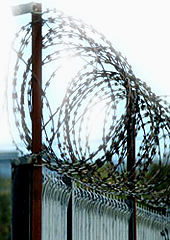My Seventh Trip to Guantanamo
What makes the U.S. military prison in Guantánamo an endlessly fascinating place?
December 20, 2007

“You just missed the Victoria’s Secret models.” Not exactly words you expect to hear at Guantánamo Bay.
An Army public affairs officer informed me of my missed brush with air-brushed beauty as I arrived for my seventh visit to the naval base best known for holding terror suspects.
But the fact that Marissa Miller and pals had just departed the island after completing a Christmas USO tour was not surprising. Almost everything about Guantánamo Bay is unexpected and unlikely.
What, after all, were the odds that 700 individuals described as terrorists and murderers would be spirited from places as disparate as Afghanistan, Bosnia and the Gambia to spend years on a Caribbean island?
How likely was it that boys as young as 14 and a man who claimed to be 105 — reportedly nicknamed “al-Qaeda Claus” by guard staff — would be detained on the beautiful seaside real estate now known as Camp Delta?
Even the U.S. government has trouble reconciling the oddities of Guantánamo. U.S. law extends to the base — it protects endangered iguanas. But U.S. law does not extend to the base — detainees have no right of habeas corpus.
The men and women stationed at Guantánamo seem to recognize the strangeness of the place. The base gift shop is packed with t-shirts and knick-knacks poking fun at the base and its mission.
Gone nowadays are some of the edgier t-shirts — “Behavior Modification Instructor” and “Taliban Towers — The Caribbean’s Newest five-star Resort.” But you can buy anything you like with an iguana on it. Also available: every manner of tacky shot glass, ornamental spoons or a camouflage beer bottle cozy that reads, “It don’t Gitmo better than this.”
That is not my first thought when I arrive at Guantánamo. Usually, I am trying to keep up with the alphabet soup of acronyms — something of an occupational hazard when your job is reporting on the military.
I had boarded a military plane at AAFB (Andrews Air Force Base in Maryland) and landed four hours later at NAVSTA GTMO (Naval Station Guantánamo). A cheerful military PAO (Public Affairs Officer) team greets our eight-person troop of journalists. They shepherd us onto a bus and help us check into our rooms at the CBQ (Combined Bachelor Quarters).
Visiting journalists file stories from the JIB (Joint Information Bureau). All our images and footage are subject to an OPSEC (Operational Security) review.
The acronyms are familiar to anyone who has worked with or alongside U.S. government agencies. But memorizing the shorthand is less important than remembering the preferred terminology of the base.
Every member of the PAO team will remind you to use “detainee” rather than “prisoner” in describing the men held at Guantánamo since 2002. The former ordinarily refers to an individual awaiting a trial, the latter a convict — though the Pentagon plans to try fewer than half of the approximately 290 men still held at the facility.
Language is a key part of the detention mission. “Gitmo-speak” has been codified in SOPs (Standard Operating Procedures) since the base began holding detainees.
A 2003 SOP, leaked on the Internet in November of that year, advises guards to avoid using the term “suicide attempt.”
“Use the phrase ‘self-injurious behavior’ in all documentation,” it instructs.
Likewise, a second SOP, from 2004, prefers “voluntary total fasting” to what is more commonly known as a hunger strike.
That phrase seems to have fallen out of favor, although hunger strikers are still a sensitive topic at Guantánamo. The standard media tour of the facility includes a visit to the detainee hospital and a careful briefing on the way hunger strikes are handled.
Journalists are shown the thin rubber feeding tube that is inserted through the nose and into the stomach of detainees on hunger strike. The detainees are strapped into a chair with their arms and legs restrained. Military personnel, however, wince at the phrase “force-feeding” — “enteral feeding” is the preferred term.
Two detainees have been “enterally fed” with a liquid nutrient mix for over 800 days.
The process is controversial in the medical community, but doctors at Guantánamo say no hunger striker will be allowed to drop much below his ideal body weight.
“It’s not an acceptable thing to let healthy people die simply as a form of protest,” one doctor told me.
For the majority of detainees, solid food is both available and abundant — so much so that obesity has become a health problem in the detainee population. Detainees can choose from a variety of daily meal plans — each with over 5,000 calories.
Elsewhere on the base, more familiar purveyors of obesity are present.
Guantánamo’s “Main Street” — Sherman Avenue — is home to a McDonald’s drive-thru much loved by base personnel. Subway, Starbucks and Pizza Hut have also set up shop in Fidel Castro’s backyard. Rumor has it that a Taco Bell is on the way.
These stores would usually be beyond the reach of detainees. But for some, Guantánamo has provided a first taste of American fast food. An FBI agent testifying during a recent military tribunal recalled sharing a pizza and hamburgers with a detainee during interrogation sessions.
For the visiting journalist, Guantánamo is an endlessly fascinating place.
Elements of the bizarre abound — as with the sign reminiscent of Magritte, the Belgian surrealist, painted onto the concrete shells of old bus stops around the base, which reads: “This will no longer be a bus stop.”
Given the frequent changes and contradictions of regulations, it’s difficult to know why a spiral-bound notebook is banned from the courtroom for being “weaponizable” — but yards of wires lie by a defendant’s feet.
It’s unclear which detainees read the dog-breeding magazines on display at the detainee library. Other bizarre reading options for the men include “Teach Yourself the Flute” — and “Don’t Worry and Start Living.”
Just as surprising as the reading tastes of detainees are the movie tastes of the men and women who guard them. The December movie rotation at the base’s two movie screens includes two showings of the recent film “Rendition.”
All of which makes it a little easier to imagine underwear models appearing in a Christmas parade just miles from hundreds of Muslim detainees. While the debate about Guantánamo’s future continues in Washington, so long as Cuban soil plays host to an American military base holding men accused of being the world’s worst terrorists, NAVSTA GTMO will be a very strange place indeed.
